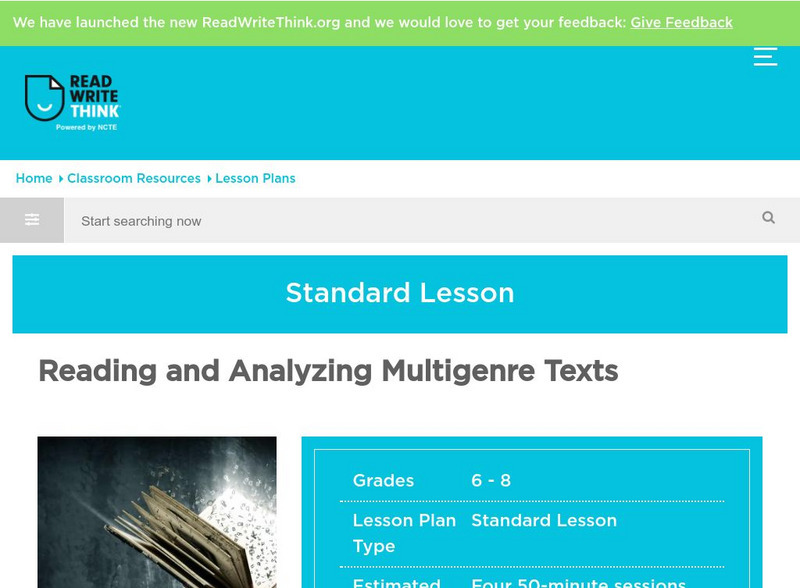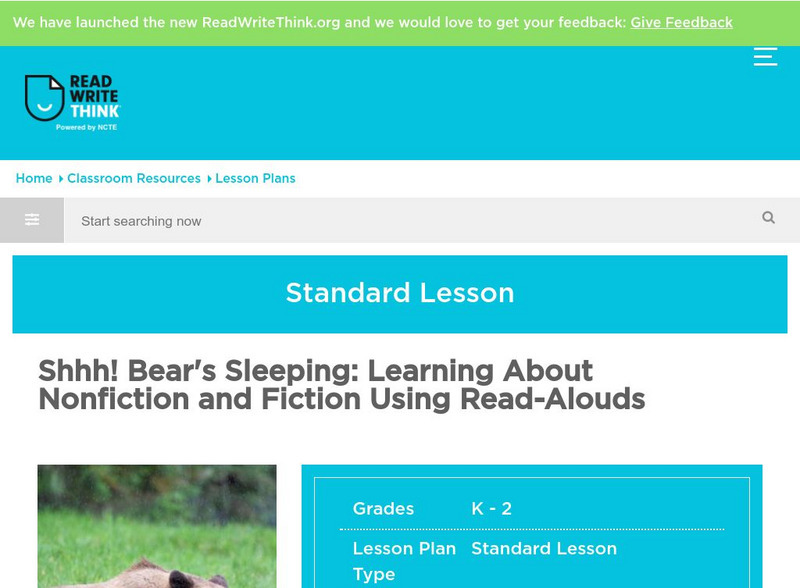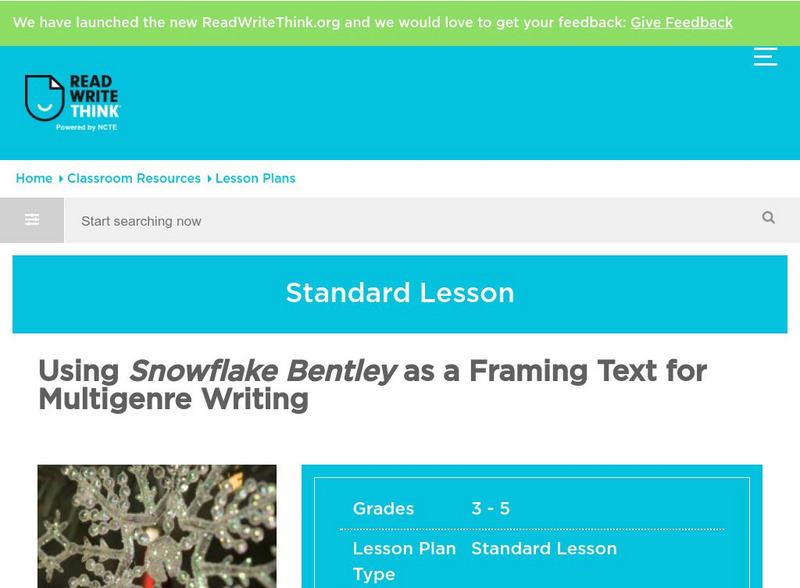Hi, what do you want to do?
Curated OER
Screening the Silver Screen
Students write New York Times Movie Guide Reviews using descriptive and persuasive language.
Curated OER
Journeys
Students write a story using their journey to school as the setting. In groups, they discuss their experiences and browse through books to get ideas for their story. They practice using a thesaurus to find new verbs or adjectives they...
Curated OER
The Time I Got Lost
Third graders go through the writing process but substitute paper and pencil with the computer to create a story about "The Time I Got Lost".
Curated OER
Make Way for Ducklings
First graders use skills to collect, organize, and interpret data. They compare and contrast two stories, Make Way for Ducklings and Chibi: A True Story From Japan. Students create a duckling.
Curated OER
Autobiographical Postage Stamp
Pupils design a postage stamp that communicates to the world who they are, what they hope to be, what they are good at, and factual information. They use, "My Great Aunt Arizona" by Gloria Houston as a model for a biography.
Curated OER
Africa
Second graders explore Africa. They label the popular places in Africa on a map. Students label the different cities and monuments that are popular in Africa. They discuss the similarities and differences between cities in Africa and...
Curated OER
911 As History
Middle schoolers recognize persuasive techniques, think criticaly about the messages contained in various media, and discuss controversial issues in constructive ways. They analyze the deeper messages contained in children's literature,...
Curated OER
The Story Was in the Details
Students explore and analyze primary documents from historical women's diaries. They conduct Internet research, develop conclusions about the primary documents, answer questions, and present their information to the class.
Curated OER
Men in Black
In this Men in Black worksheet, learners answer seven questions about the Men in Black movie relating to UFOs, time capsules, characters, vocabulary, and themes. Students answer questions in short answer format.
Curated OER
Online Newspaper Search
Learners use the Internet to research an article. When they find an article they like, it be printed and they highlight the important information and present to the class.
Read Works
Read Works: A Wrinkle in Time 6th Grade Unit
[Free Registration/Login Required] This ReadWorks Unit engages students in a deep study of Madeleine L'Engle's science fiction work, A Wrinkle in Time. Students will investigate the following topics: the book's theme, the science fiction...
ReadWriteThink
Read Write Think: Reading and Analyzing Multigenre Texts
This lesson plan deals with the process of analyzing a variety of literary texts from poetry and letters to diary entries and works of fiction. Included in the lesson plan is an overview, practice, objectives, resources, preparation, and...
Read Works
Read Works: Grade 2: Three Lesson Unit: Genre
[Free Registration/Login Required] A series of three lesson plans designed to teach students to compare and contrast fiction and non-fiction, identify the characteristics of non-fiction, and use guide words to locate topics in an...
Read Works
Read Works: Genre 4th Grade Unit: Historical Fiction
[Free Registration/Login Required] A unit of instruction in which students use the book Meet Addy: An American Girl by Connie Porter to learn about the characteristics that define historical fiction. Lesson includes direct teaching,...
Read Works
Read Works: 1st Grade Lesson: Classifying Texts
[Free Registration/Login Required] A lesson in which students use the books Froggy Goes to School by Jonathan London and Life Cycle of a Frog by Angela Royston to learn to classify texts as fiction or nonfiction. Lesson includes direct...
Read Works
Read Works: 1st Grade Lesson: Purposes for Reading
[Free Registration/Login Required] A lesson in which students use the books Nature's Food Chains: What Polar Animals Eat by Joanne Mattern, Life Cycle of a Frog by Angela Royston, and Froggy Goes to School by Jonathan London to learn to...
ReadWriteThink
Read Write Think: Shhh! Bear's Sleeping: Learning About Nonfiction and Fiction
Students explore the distinction between the fiction story Bear Snores On and the nonfiction book Every Autumn Comes the Bear.
Florida Center for Reading Research
Florida Center for Reading Research: Fiction and Nonfiction Sort [Pdf]
A lesson plan in which students look at different books, write their titles, and sort them according to whether they are fiction or nonfiction. Materials are included.
ReadWriteThink
Read Write Think: Using Snowflake Bentley as a Framing Text for Multigenre Writing
Using Snowflake Bentley as a model, students create a working definition of multigenre text and then use that definition to create their own multigenre piece about winter or another theme.
Read Works
Read Works: Fact and Opinion 3rd Grade Unit
[Free Registration/Login Required] A three-lesson unit on fact and opinion through which students learn how to identify facts and opinions in different fiction genres. Students also use non-fiction texts to identify and verify facts and...
British Library
British Library: 19th Century Non Fiction Texts: Work & Welfare
This thematic collection will allow students to read and understand 19th-century non-fiction texts, and support them in identifying key features for a range of genres, audiences, and purposes. Each source is accompanied by original...
British Library
British Library: 19th Century Non Fiction Texts: Gender, Behaviour & Etiquette
This thematic collection will allow students to read and understand 19th-century non-fiction texts, and support them in identifying key features for a range of genres, audiences, and purposes. Each source is accompanied by original...






















![Florida Center for Reading Research: Fiction and Nonfiction Sort [Pdf] Lesson Plan Florida Center for Reading Research: Fiction and Nonfiction Sort [Pdf] Lesson Plan](https://content.lessonplanet.com/knovation/original/509105-4469283d2301f2d80ae09183a55b8e2c.jpg?1661786967)


